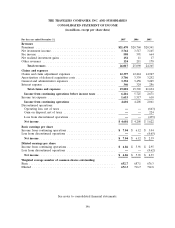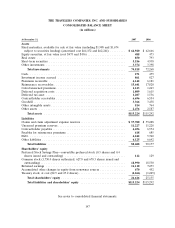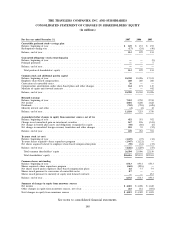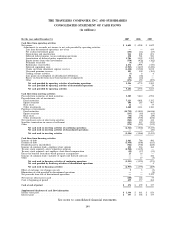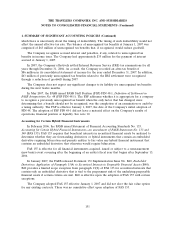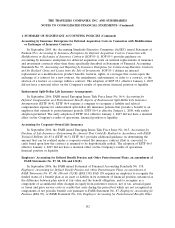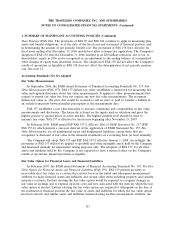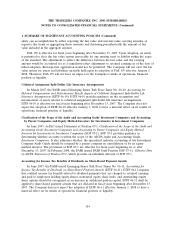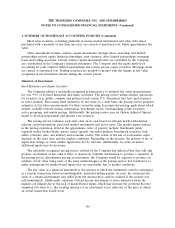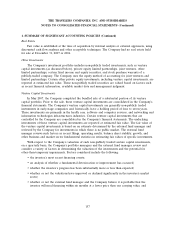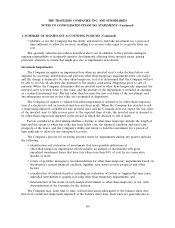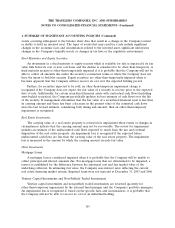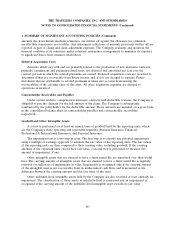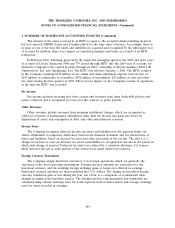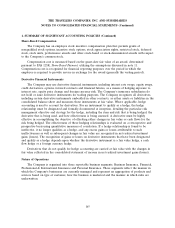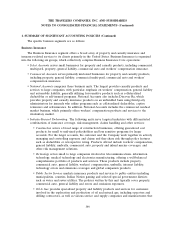Travelers 2007 Annual Report Download - page 168
Download and view the complete annual report
Please find page 168 of the 2007 Travelers annual report below. You can navigate through the pages in the report by either clicking on the pages listed below, or by using the keyword search tool below to find specific information within the annual report.THE TRAVELERS COMPANIES, INC. AND SUBSIDIARIES
NOTES TO CONSOLIDATED FINANCIAL STATEMENTS (Continued)
1. SUMMARY OF SIGNIFICANT ACCOUNTING POLICIES (Continued)
Short-term securities, consisting primarily of money market instruments and other debt issues
purchased with a maturity of less than one year, are carried at amortized cost, which approximates fair
value.
Other investments include: venture capital investments, through direct ownership and limited
partnerships; private equity limited partnerships; joint ventures; other limited partnerships; mortgage
loans and trading securities. Certain venture capital investments that are controlled by the Company
are consolidated in the Company’s financial statements. The Company uses the equity method of
accounting for joint ventures, limited partnerships and certain private equity securities. Mortgage loans
are carried at amortized cost. Trading securities are marked to market with the change in fair value
recognized in net investment income during the current period.
Valuation of Investments
Fixed Maturities and Equity Securities
The Company utilizes a nationally recognized pricing service to estimate fair value measurements
for over 99% of its fixed maturities and equity securities. The pricing service utilizes market quotations
for securities (e.g., public common and preferred and certain U.S. Treasuries) that have quoted prices
in active markets. Since many fixed maturities do not trade on a daily basis, the pricing service prepares
estimates of fair value measurements for these securities using its proprietary pricing applications which
include available relevant market information, benchmark curves, benchmarking of like securities,
sector groupings, and matrix pricing. Additionally, the pricing service uses an Option Adjusted Spread
model to develop prepayment and interest rate scenarios.
The pricing service evaluates each asset class on its own based on relevant market information,
relevant credit information, perceived market movements and sector news. The market inputs utilized
in the pricing evaluation, listed in the approximate order of priority, include: benchmark yields,
reported trades, broker/dealer quotes, issuer spreads, two-sided markets, benchmark securities, bids,
offers, reference data, and industry and economic events. The extent of the use of each market input
depends on the asset class and the market conditions. Depending on the security, the priority of use of
inputs may change or some market inputs may not be relevant. Additionally, for some securities
additional inputs may be necessary.
The nationally recognized pricing service utilized by the Company has indicated that they will only
produce an estimate of fair value if there is objectively verifiable information to produce a valuation. If
the pricing service discontinues pricing an investment, the Company would be required to produce an
estimate of fair value using some of the same methodologies as the pricing service, but would have to
make assumptions for market-based inputs that are unavailable due to market conditions.
The fair value of a financial instrument is the amount at which the instrument could be exchanged
in a current transaction between knowledgeable, unrelated willing parties. As such, the estimated fair
value of a financial instrument may differ from the amount that could be realized if the security was
sold immediately. Additionally, valuation of fixed income investments is more subjective when the
markets are illiquid due to the lack of market-based inputs, which may increase the potential that the
estimated fair value (i.e., the carrying amount) of an investment is not reflective of the price at which
an actual transaction would occur.
156


